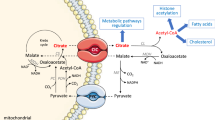Abstract
The citric acid cycle is the final common oxidative pathway for carbohydrates, fats and amino acids. It is the most important metabolic pathway for the energy supply to the body. TCA is the most important central pathway connecting almost all the individual metabolic pathways. In this review article, introduction, regulation and energetics of TCA cycle have been discussed. The present study was carried out to review literature on TCA cycle.
Similar content being viewed by others
References
Abdel-aleem, S., Nada, M. A., Sayed-Ahmed, M., Hendrickson, S. C., St Louis, J., Walthall, H. P., et al. (1996). Regulation of fatty acid oxidation by acetyl-CoA generated from glucose utilization in isolated myocytes. Journal of Molecular and Cellular Cardiology, 28(5), 825–833.
Akiba, T., Hiraga, K., & Tuboi, S. (1984). Intracellular distribution of fumarase in various animals. Journal of Biochemistry (Tokyo), 96, 189–195.
Baldwin, J. E., & Krebs, H. (1981). The evaluation of metabolic cycle. Nature, 292, 291–381.
Bowtell, J. L., Marwood, S., Bruce, M., Constantin-Teodosiu, D., & Greenhaff, P. L. (2007). Tricarboxylic acid cycle intermediate pool size: Functional importance for oxidative metabolism in exercising human skeletal muscle. Sports Medicine (Auckland, N. Z.), 37(12), 1071–1088.
Briere, J. J., Favier, J., El Ghouzzi, V., Djouadi, F., Benit, P., Gimenez, A. P., et al. (2005). Succinate dehydrogenase deficiency in human. Cellular and Molecular Life Sciences, 62, 2317–2324.
Costello, L. C., & Franklin, R. B. (1981). Aconitase activity, citrate oxidation, and zinc inhibition in rat ventral prostate. Enzyme, 26, 281–287.
Fonnum, F., Johnsen, A., & Hassel, B. (1997). Use of fluorocitrate and fluoroacetate in the study of brain metabolism. Glia, 21(1), 106–113.
Hellemond, J. J., Opperdoes, F. R., & Tielens, A. G. (2005). The extraordinary mitochondrion and unusual citric acid cycle in Trypanosoma brucei van. Biochemical Society Transactions, 33(5), 967–971.
Jones, J. G., Sherry, A. D., Jeffrey, F. M., Storey, C. J., & Malloy, C. R. (1993). Sources of acetyl-CoA entering the tricarboxylic acid cycle as determined by analysis of succinate 13C isotopomers. Biochemistry, 32(45), 12240–12244.
Kamzolova, S. V., Shishkanova, N. V., Morgunov, I. G., & Finogenova, T. V. (2003). Oxygen requirements for growth and citric acid production of Yarrowia lipolytica. FEMS Yeast Research, 3(2), 217–222.
Krebs, H. A. (1970). The history of the tricarboxylic acid cycle. Perspectives in Biology and Medicine, 14(1), 154–170.
Melendez, E., Waddell, T., & Cascante, M. (1996). The puzzle of the citric acid cycle. Journal of Molecular Evolution, 43, 293–303.
Nazaret, C., Heiske, M., Thurley, K., & Mazat, J. P. (2009). Mitochondrial energetic metabolism: A simplified model of TCA cycle with ATP production. Journal of Theoretical Biology, 258(3), 455–464.
Reeds, P. J., Berthold, H. K., Boza, J. J., Burrin, D. G., Jahoor, F., Jaksic, T., et al. (1997). Integration of amino acid and carbon intermediary metabolism: Studies with uniformly labeled tracers and mass isotopomer analysis. European Journal of Pediatrics, 156(1), 50–58.
Srere, P. A. (1975). The enzymology of the formation and breakdown of citrate. Advanced Enzymology, 43, 57.
Wan, B., LaNoue, K. F., Cheung, J. Y., & Scaduto, R. C, Jr. (1989). Regulation of citric acid cycle by calcium. Journal of Biological Chemistry, 264(23), 13430–13439.
Zatta, P., Lain, E., & Cagnolini, C. (2000). Effects of aluminum on activity of Krebs cycle enzymes and glutamate dehydrogenase in rat brain homogenate. European Journal of Biochemistry, 267(10), 3049–3055.
Author information
Authors and Affiliations
Corresponding author
Rights and permissions
About this article
Cite this article
Akram, M. Citric Acid Cycle and Role of its Intermediates in Metabolism. Cell Biochem Biophys 68, 475–478 (2014). https://doi.org/10.1007/s12013-013-9750-1
Published:
Issue Date:
DOI: https://doi.org/10.1007/s12013-013-9750-1




